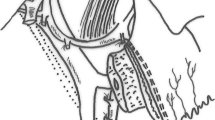Abstract
In 1994, a technique of omental flap interposition to cover the celiac and mesenteric vessels after pancreaticoduodenectomy was described. It aimed to isolate the pancreatic anastomosis from the vessels dissected during pancreaticoduodenectomy. In liver transplantation (LT), the omental flap was initially used to reduce the risk of hepatic artery (HA) kinking. Currently, we use this technique to cover the dissected HA, reducing the consequences of postoperative biliary fistula (BF), particularly the risk of postoperative complications (thrombosis/bleeding). We describe this technique adding a simple modification consisting of covering the HA with an omental flap after completion of the biliary anastomosis. We performed LT with an omental flap to cover the HA vessels in 62 (55 %) of the 112 consecutive patients who underwent LT between January 2012 and July 2013. No postoperative deaths occurred. The rate of BF was 9.7 % (six cases). In the omental flap series, no postoperative thrombosis, HA pseudoaneurysm, or complications occurred. In the six cases of BF, the dissected HAs were completely isolated from the biloma. This simple technique has no specific morbidity; it isolates the HA from the biliary anastomosis and therefore may reduce the risk of severe postoperative HA complications after LT.



Similar content being viewed by others
References
Ayoub WS, Esquivel CO, Martin P. Biliary complications following liver transplantation. Dig Dis Sci. 2010 ;55(6):1540–6. doi: 10.1007/s10620-010-1217-2.
López-Andújar R, Orón EM, Carregnato AF, Suárez FV, Herraiz AM, Rodríguez FS, Carbó JJ, Ibars EP, Sos JE, Suárez AR, Castillo MP, Pallardó JM, De Juan Burgueño M. T-tube or no T-tube in cadaveric orthotopic liver transplantation: the eternal dilemma: results of a prospective and randomized clinical trial. Ann Surg. 2013; 258(1):21–9.
Welling TH, Heidt DG, Englesbe MJ, Magee JC, Sung RS, Campbell DA, Punch JD, Pelletier SJ. Biliary complications following liver transplantation in the model for end-stage liver disease era: effect of donor, recipient, and technical factors. Liver Transpl. 2008; 14(1):73–80.
Panaro F, Miggino M, Bouyabrine H, Carabalona JP, Berthet JP, Canaud L, Nougaret S, Ramos J, Navarro F. Reversed Saphenous Bypass for Hepatic Artery Pseudoaneurysm After Liver Transplantation. Ann Vasc Surg. 2013 Aug 21. doi:pii: S0890-5096(13)00236-7. 10.1016/j.avsg.2013.01.007.
Moriura S, Ikeda S, Ikezawa T, Naiki K. The inclusion of an omental flap in pancreaticoduodenectomy. Surg Today 1994;24:940–1.
Kurosaki I, Hatekeyama K. Omental wrapping of skeletonized major vessels after pancreaticoduodenectomy. Int Surg 2004;89:90–4.
Maeda E, Ebata T, Kanemoto H, et al. Omental flap in pancreaticoduodenectomy for protection of splanchnic vessels. World J Surg 2005;29:1122–6.
Sakamoto Y, Shimada K, Esaki M, Kajiwara T, Sano T, Kosuge T. Wrapping the stump of the gastroduodenal artery using the falciform ligament during pancreaticoduodenectomy. J Am Coll Surg 2007;204:334–6.
Turrini O, Delpero JR. Omental flap for vessel coverage during pancreaticoduodenectomy: A modified technique. J Visc Surg 2009;146:545–548.
Ye QF, Niu Y, She XG, Ming YZ, Cheng K, Ma Y, Ren ZH. Pedicled greater omentum flap for preventing bile leak in liver transplantation patients with poor biliary tract conditions. Hepatobiliary Pancreat Dis Int. 2007; 6(5):470–3.
Starzl TE, Marchioro TL, Vonkaulla KN, Hermann G, Brittain RS, Waddell WR. Homotransplantation of the liver in humans. Surg Gynecol Obstet. 1963; 117:659–76.
Panaro F, Bouyabrine H, Carabalona JP, Marchand JP, Jaber S, Navarro F. Hepatic artery kinking during liver transplantation: survey and prospective intraoperative flow measurement. J Gastrointest Surg. 2012; 16(8):1524–30. doi: 10.1007/s11605-012-1897-3.
Saad WE. Management of nonocclusive hepatic artery complications after liver transplantation. Tech Vasc Interv Radiol. 2007; 10(3):221–32.
Panaro F, Glaise A, Miggino M, Bouyabrine H, Carabalona J, Gallix B, Navarro F. Rubber transcystic drainage reduces the post-removal biliary complications in liver transplantation: a matched case–control study. Langenbecks Arch Surg. 2013 Jan;398(1):169–76. doi: 10.1007/s00423-012-0970-4. Epub 2012 Jun 21.
Funding
The authors have declared no funding.
Conflict of Interest
The authors have declared no conflict of interest.
Author information
Authors and Affiliations
Corresponding author
Additional information
Fabrizio Panaro and Hassan Bouyabrine contributed equally to this work.
Rights and permissions
About this article
Cite this article
Panaro, F., Bouyabrine, H., Carabalona, JP. et al. Omental Flap for Hepatic Artery Coverage During Liver Transplantation. J Gastrointest Surg 18, 1518–1522 (2014). https://doi.org/10.1007/s11605-014-2484-6
Received:
Accepted:
Published:
Issue Date:
DOI: https://doi.org/10.1007/s11605-014-2484-6




